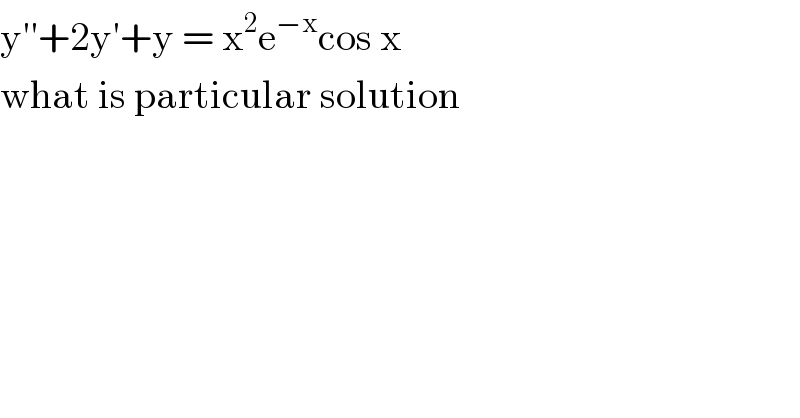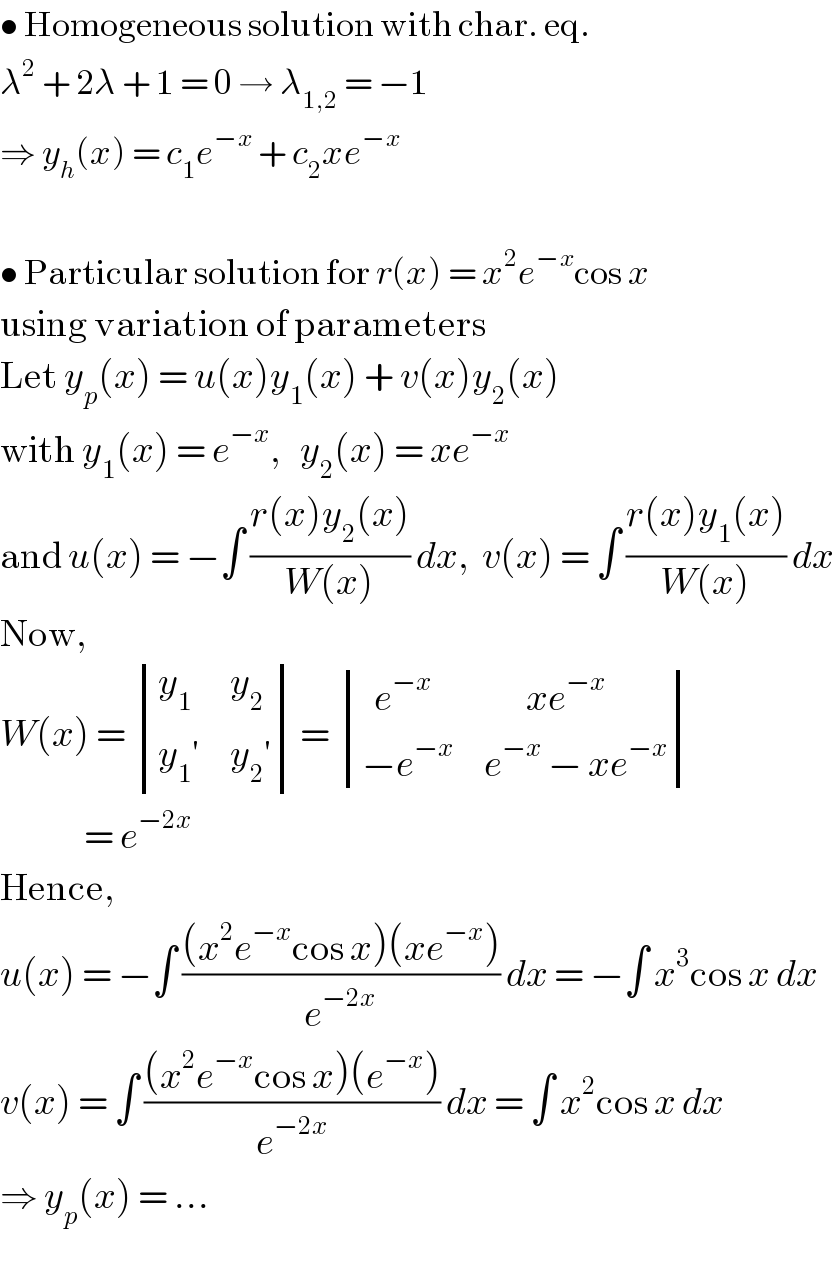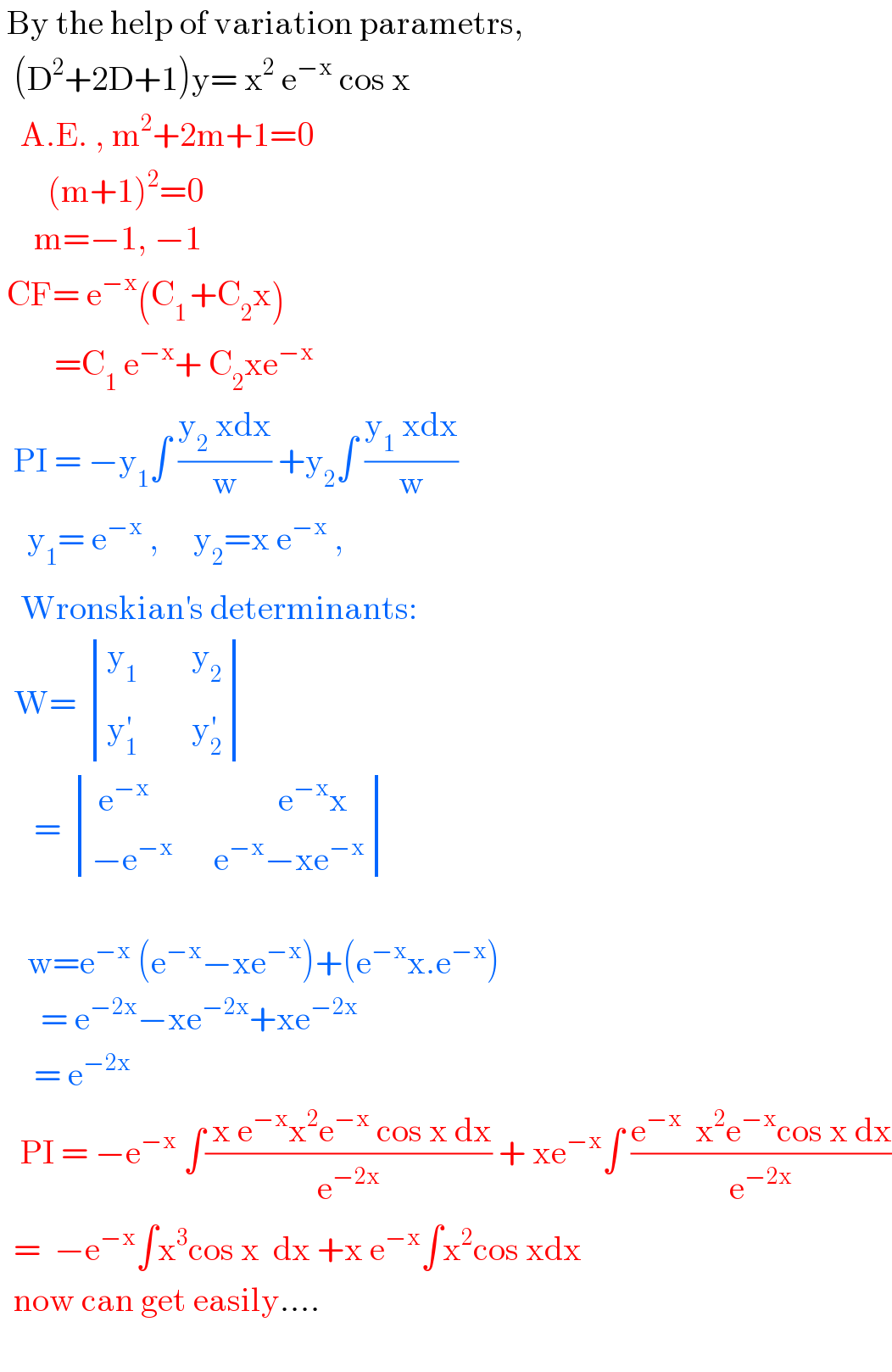
Previous in Differential Equation Next in Differential Equation
Question Number 92852 by i jagooll last updated on 09/May/20

$$\mathrm{y}''+\mathrm{2y}'+\mathrm{y}\:=\:\mathrm{x}^{\mathrm{2}} \mathrm{e}^{−\mathrm{x}} \mathrm{cos}\:\mathrm{x} \\ $$$$\mathrm{what}\:\mathrm{is}\:\mathrm{particular}\:\mathrm{solution} \\ $$$$ \\ $$
Commented by i jagooll last updated on 09/May/20
Mr Niroj's favorite ����
Answered by Joel578 last updated on 09/May/20

$$\bullet\:\mathrm{Homogeneous}\:\mathrm{solution}\:\mathrm{with}\:\mathrm{char}.\:\mathrm{eq}. \\ $$$$\lambda^{\mathrm{2}} \:+\:\mathrm{2}\lambda\:+\:\mathrm{1}\:=\:\mathrm{0}\:\rightarrow\:\lambda_{\mathrm{1},\mathrm{2}} \:=\:−\mathrm{1} \\ $$$$\Rightarrow\:{y}_{{h}} \left({x}\right)\:=\:{c}_{\mathrm{1}} {e}^{−{x}} \:+\:{c}_{\mathrm{2}} {xe}^{−{x}} \\ $$$$ \\ $$$$\bullet\:\mathrm{Particular}\:\mathrm{solution}\:\mathrm{for}\:{r}\left({x}\right)\:=\:{x}^{\mathrm{2}} {e}^{−{x}} \mathrm{cos}\:{x} \\ $$$$\mathrm{using}\:\mathrm{variation}\:\mathrm{of}\:\mathrm{parameters} \\ $$$$\mathrm{Let}\:{y}_{{p}} \left({x}\right)\:=\:{u}\left({x}\right){y}_{\mathrm{1}} \left({x}\right)\:+\:{v}\left({x}\right){y}_{\mathrm{2}} \left({x}\right) \\ $$$$\mathrm{with}\:{y}_{\mathrm{1}} \left({x}\right)\:=\:{e}^{−{x}} ,\:\:\:{y}_{\mathrm{2}} \left({x}\right)\:=\:{xe}^{−{x}} \\ $$$$\mathrm{and}\:{u}\left({x}\right)\:=\:−\int\:\frac{{r}\left({x}\right){y}_{\mathrm{2}} \left({x}\right)}{{W}\left({x}\right)}\:{dx},\:\:{v}\left({x}\right)\:=\:\int\:\frac{{r}\left({x}\right){y}_{\mathrm{1}} \left({x}\right)}{{W}\left({x}\right)}\:{dx} \\ $$$$\mathrm{Now},\: \\ $$$${W}\left({x}\right)\:=\:\begin{vmatrix}{{y}_{\mathrm{1}} }&{{y}_{\mathrm{2}} }\\{{y}_{\mathrm{1}} '}&{{y}_{\mathrm{2}} '}\end{vmatrix}=\:\begin{vmatrix}{\:\:{e}^{−{x}} }&{\:\:\:\:\:\:\:{xe}^{−{x}} }\\{−{e}^{−{x}} }&{{e}^{−{x}} \:−\:{xe}^{−{x}} }\end{vmatrix} \\ $$$$\:\:\:\:\:\:\:\:\:\:\:\:\:\:=\:{e}^{−\mathrm{2}{x}} \\ $$$$\mathrm{Hence}, \\ $$$${u}\left({x}\right)\:=\:−\int\:\frac{\left({x}^{\mathrm{2}} {e}^{−{x}} \mathrm{cos}\:{x}\right)\left({xe}^{−{x}} \right)}{{e}^{−\mathrm{2}{x}} }\:{dx}\:=\:−\int\:{x}^{\mathrm{3}} \mathrm{cos}\:{x}\:{dx} \\ $$$${v}\left({x}\right)\:=\:\int\:\frac{\left({x}^{\mathrm{2}} {e}^{−{x}} \mathrm{cos}\:{x}\right)\left({e}^{−{x}} \right)}{{e}^{−\mathrm{2}{x}} }\:{dx}\:=\:\int\:{x}^{\mathrm{2}} \mathrm{cos}\:{x}\:{dx} \\ $$$$\Rightarrow\:{y}_{{p}} \left({x}\right)\:=\:... \\ $$
Commented by i jagooll last updated on 09/May/20

$$\mathrm{tobe}\:\mathrm{continue}\:\mathrm{sir} \\ $$
Commented by Joel578 last updated on 09/May/20

$$\mathrm{I}\:\mathrm{think}\:\mathrm{the}\:\mathrm{integrals}\:\mathrm{are}\:\mathrm{easy}\:\mathrm{for}\:\mathrm{someone}\:\mathrm{that}\:\mathrm{asking} \\ $$$$\mathrm{an}\:\mathrm{ODE}\:\mathrm{problem},\:\mathrm{so}\:\mathrm{I}\:\mathrm{leave}\:\mathrm{the}\:\mathrm{rest}\:\mathrm{for}\:\mathrm{you} \\ $$
Commented by Joel578 last updated on 09/May/20
������
Commented by i jagooll last updated on 09/May/20
��������
Commented by i jagooll last updated on 09/May/20

$$\mathrm{v}\left(\mathrm{x}\right)=\mathrm{x}^{\mathrm{2}} \mathrm{sin}\:\mathrm{x}+\mathrm{2xcos}\:\mathrm{x}−\mathrm{2sin}\:\mathrm{x} \\ $$$$\mathrm{u}\left(\mathrm{x}\right)\:=−\mathrm{x}^{\mathrm{3}} \mathrm{sin}\:\mathrm{x}−\mathrm{3x}^{\mathrm{2}} \mathrm{cos}\:\mathrm{x}+\mathrm{6xsin}\:\mathrm{x}+\mathrm{6cos}\:\mathrm{x} \\ $$
Answered by niroj last updated on 09/May/20
![PI = (( x^2 e^(−x) cos x)/(D^2 +2D+1)) = e^(−x) (( x^2 cos x)/(−1+2D+1)) = e^(−x) (( x^2 cos x)/(2D)) = (e^(−x) /2)∫x^2 cos x dx x^2 (sin x)−∫2x( sin x )dx x^2 sin x−2[ x (−cos x) −∫1.(−cosx) dx] x^2 sin x +2x cosx+2sin x . PI= (e^(−x) /2)(x^2 sin x+2xcos x+2 sinx) = e^(−x) ((1/2)x^2 sin x+ x cos x+ sin x).](Q92864.png)
$$\:\:\:\mathrm{PI}\:=\:\frac{\:\mathrm{x}^{\mathrm{2}} \mathrm{e}^{−\mathrm{x}} \mathrm{cos}\:\mathrm{x}}{\mathrm{D}^{\mathrm{2}} +\mathrm{2D}+\mathrm{1}}\: \\ $$$$\:\:\:\:=\:\mathrm{e}^{−\mathrm{x}} \:\frac{\:\mathrm{x}^{\mathrm{2}} \:\mathrm{cos}\:\mathrm{x}}{−\mathrm{1}+\mathrm{2D}+\mathrm{1}} \\ $$$$\:\:\:\:=\:\mathrm{e}^{−\mathrm{x}} \frac{\:\mathrm{x}^{\mathrm{2}} \mathrm{cos}\:\mathrm{x}}{\mathrm{2D}} \\ $$$$\:\:\:\:\:\:=\:\frac{\mathrm{e}^{−\mathrm{x}} }{\mathrm{2}}\int\mathrm{x}^{\mathrm{2}} \:\mathrm{cos}\:\mathrm{x}\:\mathrm{dx} \\ $$$$\:\:\:\:\:\:\mathrm{x}^{\mathrm{2}} \left(\mathrm{sin}\:\mathrm{x}\right)−\int\mathrm{2x}\left(\:\mathrm{sin}\:\mathrm{x}\:\right)\mathrm{dx} \\ $$$$\:\:\:\:\mathrm{x}^{\mathrm{2}} \:\mathrm{sin}\:\mathrm{x}−\mathrm{2}\left[\:\mathrm{x}\:\left(−\mathrm{cos}\:\mathrm{x}\right)\:−\int\mathrm{1}.\left(−\mathrm{cosx}\right)\:\mathrm{dx}\right] \\ $$$$\:\:\mathrm{x}^{\mathrm{2}} \mathrm{sin}\:\mathrm{x}\:+\mathrm{2x}\:\mathrm{cosx}+\mathrm{2sin}\:\mathrm{x}\:. \\ $$$$\:\mathrm{PI}=\:\frac{\mathrm{e}^{−\mathrm{x}} }{\mathrm{2}}\left(\mathrm{x}^{\mathrm{2}} \mathrm{sin}\:\mathrm{x}+\mathrm{2xcos}\:\mathrm{x}+\mathrm{2}\:\mathrm{sinx}\right) \\ $$$$\:\:\:\:=\:\mathrm{e}^{−\mathrm{x}} \:\left(\frac{\mathrm{1}}{\mathrm{2}}\mathrm{x}^{\mathrm{2}} \mathrm{sin}\:\mathrm{x}+\:\mathrm{x}\:\mathrm{cos}\:\mathrm{x}+\:\mathrm{sin}\:\mathrm{x}\right). \\ $$$$\:\: \\ $$$$\:\: \\ $$$$ \\ $$
Commented by i jagooll last updated on 09/May/20
I have a lot to learn in this way sir ������
Commented by niroj last updated on 09/May/20

$$\:\mathrm{you}\:\mathrm{can}\:\mathrm{solve}\:\mathrm{by}\:\mathrm{other}\:\mathrm{method}\:\mathrm{also} \\ $$$$\:\mathrm{like}\:\mathrm{using}\:\mathrm{by}\:\mathrm{variation}\:\mathrm{of}\:\mathrm{parameter}. \\ $$
Answered by niroj last updated on 09/May/20

$$\:\mathrm{By}\:\mathrm{the}\:\mathrm{help}\:\mathrm{of}\:\mathrm{variation}\:\mathrm{parametrs}, \\ $$$$\:\:\left(\mathrm{D}^{\mathrm{2}} +\mathrm{2D}+\mathrm{1}\right)\mathrm{y}=\:\mathrm{x}^{\mathrm{2}} \:\mathrm{e}^{−\mathrm{x}} \:\mathrm{cos}\:\mathrm{x} \\ $$$$\:\:\:\mathrm{A}.\mathrm{E}.\:,\:\mathrm{m}^{\mathrm{2}} +\mathrm{2m}+\mathrm{1}=\mathrm{0} \\ $$$$\:\:\:\:\:\:\:\left(\mathrm{m}+\mathrm{1}\right)^{\mathrm{2}} =\mathrm{0} \\ $$$$\:\:\:\:\:\mathrm{m}=−\mathrm{1},\:−\mathrm{1} \\ $$$$\:\mathrm{CF}=\:\mathrm{e}^{−\mathrm{x}} \left(\mathrm{C}_{\mathrm{1}\:} +\mathrm{C}_{\mathrm{2}} \mathrm{x}\right) \\ $$$$\:\:\:\:\:\:\:\:=\mathrm{C}_{\mathrm{1}} \:\mathrm{e}^{−\mathrm{x}} +\:\mathrm{C}_{\mathrm{2}} \mathrm{xe}^{−\mathrm{x}} \\ $$$$\:\:\mathrm{PI}\:=\:−\mathrm{y}_{\mathrm{1}} \int\:\frac{\mathrm{y}_{\mathrm{2}} \:\mathrm{xdx}}{\mathrm{w}}\:+\mathrm{y}_{\mathrm{2}} \int\:\frac{\mathrm{y}_{\mathrm{1}} \:\mathrm{xdx}}{\mathrm{w}} \\ $$$$\:\:\:\:\mathrm{y}_{\mathrm{1}} =\:\mathrm{e}^{−\mathrm{x}} \:,\:\:\:\:\:\mathrm{y}_{\mathrm{2}} =\mathrm{x}\:\mathrm{e}^{−\mathrm{x}} \:,\: \\ $$$$\:\:\:\mathrm{Wronskian}^{'} \mathrm{s}\:\mathrm{determinants}: \\ $$$$\:\:\mathrm{W}=\:\begin{vmatrix}{\mathrm{y}_{\mathrm{1}} \:\:\:\:\:\:\:\:\mathrm{y}_{\mathrm{2}} }\\{\mathrm{y}_{\mathrm{1}} ^{'} \:\:\:\:\:\:\:\:\mathrm{y}_{\mathrm{2}} ^{'} }\end{vmatrix} \\ $$$$\:\:\:\:\:=\:\begin{vmatrix}{\:\mathrm{e}^{−\mathrm{x}} \:\:\:\:\:\:\:\:\:\:\:\:\:\:\:\:\:\:\:\mathrm{e}^{−\mathrm{x}} \mathrm{x}}\\{−\mathrm{e}^{−\mathrm{x}} \:\:\:\:\:\:\mathrm{e}^{−\mathrm{x}} −\mathrm{xe}^{−\mathrm{x}} }\end{vmatrix} \\ $$$$\:\:\: \\ $$$$\:\:\:\:\mathrm{w}=\mathrm{e}^{−\mathrm{x}} \:\left(\mathrm{e}^{−\mathrm{x}} −\mathrm{xe}^{−\mathrm{x}} \right)+\left(\mathrm{e}^{−\mathrm{x}} \mathrm{x}.\mathrm{e}^{−\mathrm{x}} \right) \\ $$$$\:\:\:\:\:\:=\:\mathrm{e}^{−\mathrm{2x}} −\mathrm{xe}^{−\mathrm{2x}} +\mathrm{xe}^{−\mathrm{2x}} \\ $$$$\:\:\:\:\:=\:\mathrm{e}^{−\mathrm{2x}} \\ $$$$\:\:\:\mathrm{PI}\:=\:−\mathrm{e}^{−\mathrm{x}} \:\int\frac{\:\mathrm{x}\:\mathrm{e}^{−\mathrm{x}} \mathrm{x}^{\mathrm{2}} \mathrm{e}^{−\mathrm{x}} \:\mathrm{cos}\:\mathrm{x}\:\mathrm{dx}}{\mathrm{e}^{−\mathrm{2x}} }\:+\:\mathrm{xe}^{−\mathrm{x}} \int\:\frac{\mathrm{e}^{−\mathrm{x}} \:\:\mathrm{x}^{\mathrm{2}} \mathrm{e}^{−\mathrm{x}} \mathrm{cos}\:\mathrm{x}\:\mathrm{dx}}{\mathrm{e}^{−\mathrm{2x}} } \\ $$$$\:\:=\:\:−\mathrm{e}^{−\mathrm{x}} \int\mathrm{x}^{\mathrm{3}} \mathrm{cos}\:\mathrm{x}\:\:\mathrm{dx}\:+\mathrm{x}\:\mathrm{e}^{−\mathrm{x}} \int\mathrm{x}^{\mathrm{2}} \mathrm{cos}\:\mathrm{xdx} \\ $$$$\:\:\mathrm{now}\:\mathrm{can}\:\mathrm{get}\:\mathrm{easily}.... \\ $$$$\:\:\:\:\:\: \\ $$
Commented by john santu last updated on 09/May/20
great...cheer ������
